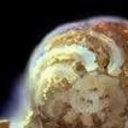Morphological and molecular analyses of host and nonhost interactions involving barley and wheat and the covered smut pathogen Ustilago hordei.
Λέξεις-κλειδιά
Αφηρημένη
Ustilago hordei interactions on coleoptiles of barley host cultivars Odessa (compatible), Hannchen (incompatible, carrying the Ruh1 resistance gene), and on nonhost Neepawa wheat were studied using light and fluorescent microscopy. Autofluorescence, mainly caused by callose accumulation, was more rapidly expressed in nonhost wheat at 30 to 72 h compared with the incompatible reaction between 72 and 144 h. Microarray results demonstrated that more than half of the 893 differentially regulated genes were observed in Neepawa; of these genes, 45% fell into the defense- and stress-related classes in Neepawa compared with 25 and 37% in Odessa and Hannchen, respectively. Their expression coincided with the early morphological defense responses observed and were associated with the jasmonic acid and ethylene (JA/ET) signaling pathway. Expression patterns in Odessa and Hannchen were similar, involving fewer genes and coinciding with later morphological defense responses of these varieties. Although no visible hypersensitive response was apparent in Hannchen or Neepawa, specific upregulation of hypersensitivity-related proteins was observed, such as beta-VPE at 48 h. Expression levels of the callose synthase gene were closely associated with callose accumulation. Differential responses in defense-gene expression among disease reaction types included upregulation of PR-1.1b and downregulation of a nonspecific lipid transfer protein in the incompatible and compatible interactions, respectively. Transcript levels of EDS1 and PAD4, involved in both basal resistance and R-mediated resistance to avirulent pathogens, were up-regulated during both nonhost and Ruh1-mediated resistance. Application of methyl-jasmonate, salicylic acid and ET to leaves revealed that only PR1.1b is strongly up-regulated by all three compounds, while the majority of the defense-related genes are only slightly up-regulated by these signaling compounds.


